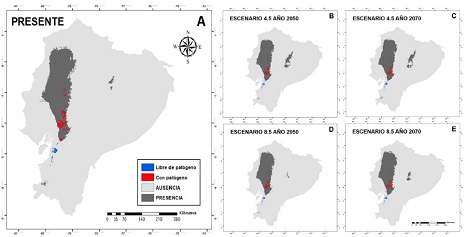Riesgo para el cultivo de cacao por los cambios en la distribución potencial del f itopatógeno Moniliophthora perniciosa bajo escenarios de cambio climático en Ecuador continental
DOI:
https://doi.org/10.28940/terra.v40i0.1338Palabras clave:
hongo f itopatógeno, MaxEnt, modelo de nicho ecológico, plantaciones comerciales, Theobroma cacaoResumen
Ecuador es un país privilegiado por sus condiciones geográf icas y climáticas, que le permiten ser uno de los mayores productores de cacao f ino y de aroma a escala mundial. Una de las limitantes más importantes para su cultivo son las enfermedades fungosas, como el f itopatógeno Moniliophthora perniciosa, que causa grandes pérdidas en la producción cacaotera. Esta investigación tuvo como objetivo evaluar el riesgo del cultivo de cacao ante los cambios de distribución geográf ica potencial de M. perniciosa bajo escenarios de cambio climático en Ecuador continental. Se obtuvieron datos de presencia del patógeno de la literatura científ ica y Niche Toolbox, y con variables bioclimáticas, seleccionadas de acuerdo con su ecología, se modeló su distribución potencial con MaxEnt. Con los mapas binarios del f itopatógeno y la capa de uso del suelo para el cultivo de cacao, se determinaron los sitios donde ambas especies coinciden espacialmente. El modelo de M. perniciosa fue transferido a Ecuador continental en el presente y a diferentes escenarios de cambios climático. El área de distribución del patógeno fue comparada entre los escenarios actuales y futuros para identif icar las pérdidas, ampliaciones y estabilidad. El mayor rango de ampliación y contracción se da en el escenario extremo RCP 8.5 2070, con 10 392 km2 y 540 km2 respectivamente. Hay un mayor rango de estabilidad durante los escenarios futuros RCP 4.5 2050 con 30 929 km2 y 2070 con 30 908 km2. Actualmente, el f itopatógeno se distribuye de manera potencial en el 74 % del área ocupada por plantaciones de cacao y en el futuro todos los escenarios indican un aumento. Las medidas de prevención, manejo y control deben incrementarse para mantener estable la producción de cacao y no afectar la economía a nivel nacional, ni de las familias de los productores.
Descargas
Publication Facts
Reviewer profiles N/D
Author statements
- Academic society
- Terra Latinoamericana

















